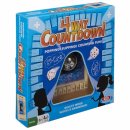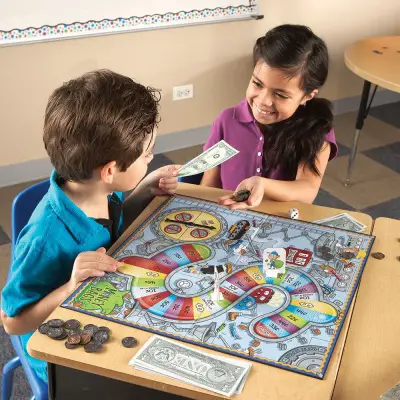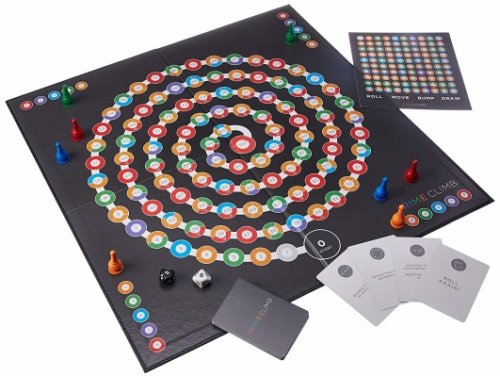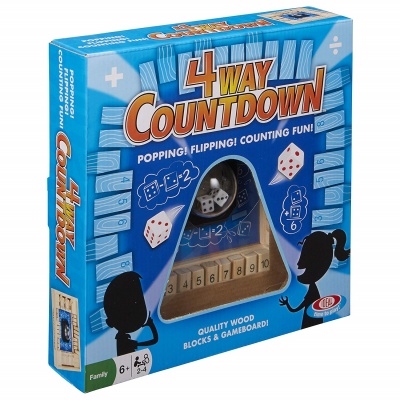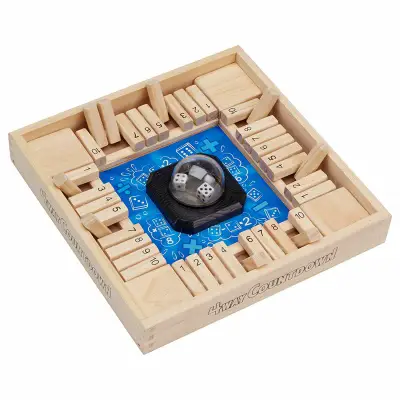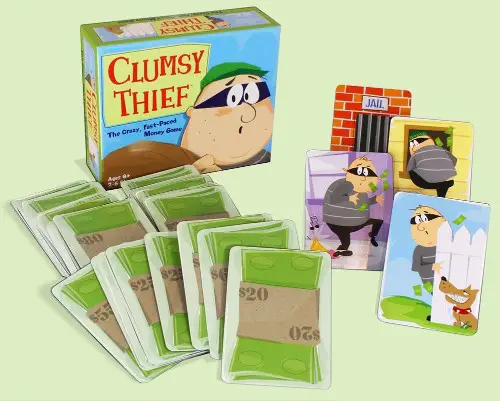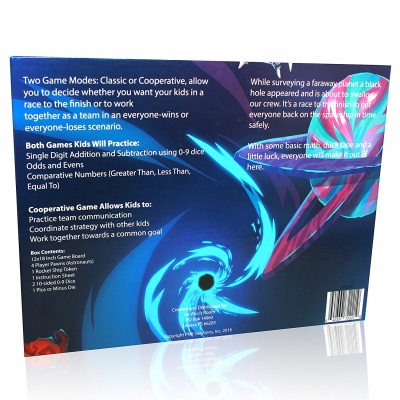10 Best Math Games Reviewed and Rated in 2024
Learning math can be difficult and research has determined that using math learning game is one of the most effective ways to learn the concept. The games take a difficult task and make them fun. These games allow kids to be able to learn basic skills, brush up on skills already learned, or be able to apply advanced math concepts outside of a classroom setting. They are fun and also help with their social development skills. Between the games and fun parents are able to turn math into a concept that everyone can love.
In a Hurry? The test winner after 26 hrs of research
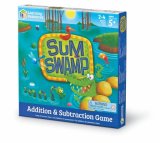
Is the winner of six awards
Is for two to four players
Develops early fluency in math
Promotes the drills of basic skills
Is colorful and exciting

10 Best Math Games
1. Learning Resources Sum Swamp
Is the winner of six awards
Is for two to four players
Develops early fluency in math
Promotes the drills of basic skills
Is colorful and exciting
Kids can outgrow this quickly
A part of the game is an endless circle making it long
The Sum Swamp Game gives practice with subtracting and adding and is the winner of six awards. It develops early fluency in math as the game is played and promotes the drills of basic math in a fun atmosphere. Perfect for kids aged five-years-old and older, this cute colorful game is for two to four players.
Read moreDesign
It comes with a game board, three dice, and four game pieces made like swamp creatures. Kids choose a play-piece of either a frog, dragonfly, platypus, or snail. Play is a path in the swamp on the board, and it is a race of shortcuts and challenges to win the game. Two dice have numbers and the third has either plus or minus operations. When all three dice are tossed, the two appearing numbers are either added or subtracted for the player to move that many places on the board. Math has never been so engaging and exciting as the Sum Swamp Game!
Value
This game has won six awards for its uniqueness and genuine cuteness. The format is fresh and inviting for children to want to practice their math talents in an amazing way.
Ease of Use
The concept of dice for math operations is quite clever. Combined with the cute swamp background, this is a truly sweet game for young kids and parents to enjoy together.
2. ThinkFun Dice Junior
Comes with a bag to carry and store it
Was nominated for Toy of the Year
Very popular with teachers and parents
Simple and easy to learn and play
Promotes critical thinking and cognitive skills
A few remarks that the dice are hard to handle and big
The instructions were confusing for some kids
The Math Dice Junior Game is the best kids first math game, and it comes with a bag to carry and store the dice. Included are five regular dice and one twelve-sided die, instructions and a scoring track.
Read moreDesign
It is for more than two players and great for children six-years-old and older. This ideal game was nominated for Toy of the Year and is very popular with teachers and parents. Math Dice is simple and easy to learn and play. Promoting critical thinking and cognitive skills, it is a fun way to learn math at home or on the go.
Value
Young children can practice the beginning skills of math adding and subtracting with these fun dice. Cognitive and critical thinking abilities will be exercised as they roll the dice.
Ease of Use
This dice game can be set up and played almost anywhere, making it a wonderful travel game. Kids of all ages love dice, and these can be enjoyed at home, traveling, or even outdoors.
3. Money Bags Coin Value
Winner of five toy awards
Teaches valuable money recognition skills
Players count, exchange, and collect money
Cute fun cartoon characters are the markers
Teaches coin combinations and exchanges
Could be boring for some kids
Does not come with a bag or box for the pieces
Winner of five toy awards and perfect for kids aged seven-years-old and up, the Money Bags Coin Value Game is exciting fun for two to four players. Included are dice, markers, play bills, plastic coins, a spinner, and a game board. It teaches valuable money recognition and counting skills as players count, exchange, and collect money in the race to the finish line.
Read moreDesign
Cute cartoon characters are the markers for the game pieces, and whoever has the most money at the end wins the game. Money is received by landing the game piece on a common chore, such as setting a table or operating a lemonade stand. The spinner determines the coins that can be obtained from the bank. It could say no pennies, and then the player must collect their money without pennies. It teaches coin combinations with the bank exchange, where players exchange, for example, two nickels for a dime. If your child needs help with coin value, recognition, exchange, or counting, then this is the perfect game to get them up to speed.
Value
More than just swapping coins, this is a board game with a goal of reaching the finish line first. The child with the most money wins the game and is considered a winner in valuing coins.
Ease of Use
Learning the money system is hard for some kids to grasp, but this game will make learning and the repetitive actions of exchanging coins and making change fun and enjoyable.
4. Love Prime Climb
Is colorful, beautiful, and award-winning
Young children can play without adults
Exercises multiplication and division
Great for families, schools, and kid groups
Promotes a deeper understanding of math
Has too many rules and instructions for a few people
Was not really fun for some kids
Prime Climb is colorful, beautiful, and award-winning, plus great for two to four players. Perfect for kids aged ten-years-old and up, this terrific game exercises multiplication and division abilities with a brightly-colored board.
Read moreDesign
Young children can play without adults, as it promotes a deeper understanding of basic math skills. It can be replayed endlessly and is easy to understand. Roll the dice and do the math, get prime cards to move your opponent backward. Movement is towards the board center and the first to get both pieces on 101 is the winner. Prime Climb is great for families, schools, and kid groups.
Value
Even though this is an enjoyable game for families, parents do not have to supervise this game as children enjoy it. it is simple enough to be played by just kids who love to do the math.
Ease of Use
Learning multiplication and division has never been so fun as it is with Prime Climb. This spiraling colorful game will excite kids as they conquer these basic math skills.
5. Ideal 4-Way CountDown
Great for children, schools, and families
Educational and fun
Includes a high-quality wooden gameboard and blocks
Uses addition, subtraction, multiplication, and division
Game of strategy, luck, and brains
A few games were missing pieces
Some kids were bored easily
Not just a game of math, 4-Way Count Down is a game of strategy, luck, and brains. It is great for two to four players and includes a dice popper, wooden gameboard, and wooden blocks.
Read moreDesign
The purpose of the game is to roll the dice to get a number between one and ten, and the first player to get all ten numbers with their blocks wins the game. When the dice are popped in the popper, each player must decide which math operation to use to get a number between one and ten that he or she needs to eliminate from their wooden blocks. For example, if a two and a four are rolled, then the player can decide to add, subtract, multiply, or divide these numbers to get a need number block of theirs out. It is ideal for kids six-years-old and older and uses addition, subtraction, multiplication, and division to play.
Value
Most math games just have the kids doing the math, but with 4-Way Count Down, kids must use some strategy too in deciding which operation to use for the numbers they get.
Ease of Use
This game can be used for years to give your child much practice with the basic four math operations. These skills take time to repeat the drills, but with this fun game, it is easy and enjoyable.
6. Learning Resources Sum Swamp
Math game focused on basic skills for grade school aged children
Help develop fluency of addition and subtraction
Great game for 2 to 4 players over the age of 5 years old
Game set includes; game board, game pieces (4), dice (2 number, one operation)
Encourages the development of math as skills grow
Finding the way out of the endless loop can be a challenge for kids
Very short game playing time
Want the kids to do math drills without them even knowing they are doing them? This game is perfect for that. It is a game that encourages kids to complete basic math drills while playing a very fun game. It practices both addition and subtractions but makes them super easy and fun.
Read moreDesign
They are able to build confidence in their math skills with this game. As kids journey through the swamp, they will meet funny swamp characters that they have to face challenges with. The goal is to complete the challenges and race through the game to the end to win. There are shortcuts set some players ahead so they have to pay attention and be ready when it is their turn. Included with the set is the game board (swamp themed), four creature pieces that are the players, two dice, and an operation dice. The game is great for 2 to 4 players that are over the ages of 5 years old. The game board has been beautifully illustrated, the markers are cute, and the dice create math drills that are fun. This learning resource game is perfect for any family game night.
Value
This is a game that has been created to ensure that kids have their basic math skills down while also having a good time doing it. It features a game that can grow with them as they grow. Children that are grade school age can find math a challenge, but this learning game is an award-winning game that won’t let them down
Ease of Use
The game is simple the skills learned are amazing. This game takes the place of any math drills that the kids are usually doing for homework and makes them fun. It is a great game for a game night that brings math and fun together, which most kids don’t usually associate together.
7. Melon Rind Clumsy Thief
Actions include snatching, counting, stacking
Fun, exciting, and fast-paced
Play builds skills in adding up to 100
Was awarded four toy and parent awards
Gives practice with strategy, and adding
Was boring for some children
The game was too simple for a couple of buyers
For a fun, exciting, and fast-paced money-changing game, look no further. The Melon Rind Clumsy Thief Game gives practice with strategy and adding in such a fun way. Actions include snatching, counting, stacking, plus the play consists of adding up to 100, taking the money, and winning the game.
Read moreDesign
It was awarded four toy and parent awards and includes illustrated rules and colorful interactive cards. Best for ages eight-years-old and up, two to six players can enjoy it, and the player with the most money wins the game. This wonderful math game contains thief and jail cards. The thief cards steal the money cards and the jail cards halt the thief cards. It is hilarious fun with money changing hands continuously. Usual play time is fifteen minutes.
Value
This math game is so adventurous that it has won multiple awards from parent groups and toy organizations for its excellence. It is a refreshing game that is leaps and bounds ahead in ingenuity.
Ease of Use
The clever concept of this game of thievery and jail will have kids involved in the fun exciting gameplay for hours. It is all to get them practicing their adding skills in such a unique way.
8. Sums in Space
Gives practice in analyzing, comparing, adding, and subtracting
Difficulty levels grow with the child
Will keep kids interested in math for years
Best suited for ages five-years-old and up
Good for classrooms or for homeschooling
Some parents did not like the artwork design
The pawn quality was disappointing for a few people
Giving practice with subtracting and adding numbers zero to nine, learning even and odd numbers, and comparing numbers with the operations of equal to, less than, and greater than, this amazing math game is great for two to four players. Sums in Space has two modes of play possible.
Read moreDesign
Kids can work together to get to the goal or compete against each other to get to the finish line. There are three levels of difficulty that will grow with the child and keep them interactive and interested in math for years. Best suited for ages five-years-old and up, it is perfect to use in classrooms or for homeschooling. Sums in Space uses a cute space theme of astronauts and a rocket ship saving the earth to promote the basic necessary math skills.
Value
More than just adding numbers, this great game gets kids to compare and analyze them for various things. Many cognitive abilities are gained, as well as critical thinking, dexterity, and fine motor talents.
Ease of Use
The space theme is adorable for both girls and boys to enjoy while they brush up on their math skills. It even has a rocket ship and an outer space black hole on the game board.
9. Pop For Addition & Subtraction
Rewards children with the gumballs
Provides practice with subtraction and addition
For ages six and older
Is a fast-paced game
Develops critical thinking and basic facts
Was not very challenging for a few children
Some were missing parts in theirs
Made like a gumball machine, this game of addition and subtraction will have your child practicing math like crazy. It rewards children for right answers with the gumballs and provides practice with subtraction, addition, and fluency in a fun way.
Read moreDesign
This is a fast-paced game for ages six and older that includes ninety cards with math facts, a spinner, and a guide. It will develop critical thinking and basic facts in children that are willing to practice their skills with this wonderful game. Parents can help get them excited by playing along and enjoying the fun.
Value
Adding and subtracting is the first challenge in math for kids to use the basic numbers they learned. It helps to have fun ways to practice these concepts because much practice is needed.
Ease of Use
The idea of the gumballs with the balls printed with the math problems is very smart and creative. It is a novel way to get kids to practice their skills in this subject.
10. Multiplication War Game Cards
Card game featuring the game of War with a multiplication spin
Set features; 52 game cards, an answer card, and parent card that has rules and ideas for the game
Fun competitive one on one game
The goal is to solve the problem with the highest card value
Cards feature bold block style lettering with a glossy finish
Cards do not feature answer on individual cards, answers on a separate sheet
Numbers 6 and 9 are not underlined for easily identification
A multiplication War game that brings math and the card game of War together in one fun filled adventure. The set includes 52 cards plus one answer card and then one parent card. It is a competitive card game that is great for kids that are learning their multiplication facts.
Read moreDesign
Two players play against each other flipping cards over and solving the problems. The player that has the highest card value then wins both of the cards. Each of the cards features large numbers that are written in bold block style print. The cards have been constructed out of thick cardstock that has a glossy finish with rounded corners on all sides to make it easier to sort. This is one of the most effective ways to practice math skills. Research has shown that flashcard type games are able to boost retention and are an excellent strategy for a number of reasons. They are able to motivate kids to leans and help with really get a deep understanding of the concept plus removes the stress of schoolwork while adding the element of fun. This allows students to focus on the game and improving their skills without the stress of a classroom setting. With a game that the rules are simple and the math concepts are challenging your kids will love putting their skills and friends to the test.
Value
Games that have a learning concept have been proven to make mastering the skill easier and less stressful for kids than a classroom setting. The game tests their skills, builds their knowledge, and boosts their retention each time it is played. A simple game of War is a lasting effect that will guide them through their whole multiplication learning experience.
Ease of Use
A card game that takes the concept of a fun competitive card game and adds the skills of math. It is a one on one game that challenges both players to really learn their multiplication and be fast at it as well.
Criteria Used for Evaluation

Design
Whether your child needs practice with subtraction, addition, multiplication, division, fractions, greater than and less than, or odd and even, these are the top games that will help develop those abilities. Most of these items are for kids to learn addition and subtractions, but a few of them also have the possibilities of the other operations too. With the gumballs, spaceships, pizza slices, swamp animals, big colorful dice, and make-believe coins and bills, these amazing games will promote the basic math skills needed for grade-school levels and get your child excited about math concepts in a fun interactive way.

Value
These are the best math games online rated by customers who overwhelmingly loved these for their children. Having the most reviews and the top ratings, we selected these wonderful games to highlight in this informative concise buying guide. We search through the feedback and reviews of consumers and the product descriptions of manufacturers to give you all of the fabulous details of each item. In this way, you can make an intelligent choice for your child based on facts. Our summary paragraphs tell you all you need to know about each product to decide if it is the perfect one for your kid. We know you only want the best for your children, so we only feature the absolute best items.

Ease of Use
The ideas of these games are simple and fun for kids. With themes that young minds can relate to, manufacturers have cleverly devised intriguing games to last for hours. Repetition is key in learning math operations, and with the colorful game pieces and boards of these games, kids will want to play. Unknowingly, they will be gaining many abilities and learning the math that is necessary for life. Some of the adorable these are astronauts in space, animals in a swamp, a gumball machine, allowance chores, and purchases, and pizzas with colorful varied toppings. The fun ideas will keep them occupied while they learn the math skills they need to succeed.
Children may start to enjoy math classes once they are introduced to engaging math games. Math will become associated with having fun and may quickly turn into their favorite subject.
The collection of math games are meant for children in elementary school, who are learning the basics in their math courses. The games can be played as a family in order to encourage their learning process and witness their progress.
Other Factors to Consider

Price Range
As we stated above, these games are fun for little kids to practice their math abilities and the themes for each are unique. Where else will your child be able to have pizzas divided up into fancy slices with toppings to learn fractions or gumballs in a machine to practice addition and subtracting? Three of these games have loads of fake dollar bills and coins to teach money values and making a change in exciting interesting ways. Nowhere else could learning math skills be this intriguing and addictive.
Frequently Asked Questions
q: What ages are these math games for?
The age that kids start to do math operations with numbers varies greatly, but the adding and subtracting usually starts in kindergarten and first grade. Ages four and five are great to begin the skills of addition and subtraction. For the multiplying and division games, children at the school age of eight or nine can do these well. Depending on what they learn at school and the grade level, these numbers can be different.
q: Do any of these give practice with multiplication and division?
Yes, Multiplication and division practice is possible with Prime Climb and 4-Way Countdown. These operations could be accomplished with a few of the other games, but they are not original components of the game as it is.
q: Can any of these be played alone? Which ones are best for families to play together?
Yes, a few of these do not need any other players. These are Pizza Fraction Fun, Pop for Addition & Subtraction, and Think Fun Dice Junior. It would be ideal for more than one person to play these, but one person can enjoy them all alone too.
q: Which games have the highest ratings from customers? Which one has the most reviews and feedback from consumers?
Sums in Space and Prime Climb have the highest ratings out of all online math games available. They have customers raving about their effectiveness and unique gameplay for their children. The game with the highest number of reviews is Sum Swamp with Think Fun Dice Junior as second.
q: Can any of these be enjoyed by small children by themselves?
Yes, the math games that can be enjoyed by small kids without adults joining in are Sum Swamp, Think Fun Dice Junior, Sums in Space, Pop for Addition & Subtraction, and Pizza Fraction Fun. Once kids know how to play these, adults are no longer needed for interactive enjoyable gameplay.
q: What kind of skills do these exercise and develop?
Many skills of the brain will be exercised with these games, as well as motor abilities and sportsmanship talents when playing with others. Children learn how to get along with others and patience through games and to allow others to take a fair turn. Fine motor abilities will be developed in picking up the small pieces and placing them where they need to go in the game, and even in setting up and taking the game down. The brain skills consist of cognitive, analyzing, comparing, problem-solving, and critical thinking.
q: Can any of these math games be played in the car or when traveling?
Yes, the ones with no or just a few small pieces and no board necessary will be great to play while on the move or traveling. The ones that are perfect for this are Think Fun Dice Junior and the Pizza Fraction Fun game. They have limited pieces and do not need a board for playing.
q: Which games have the least number of loose pieces that would be a problem for picking up and keeping together?
The games with the least number of pieces are Pizza Fraction Fun and Think Fun Dice Junior. The others have many pieces for board games that include pawns, cards, and denominations of money in bills and coins. The Pizza Fraction Fun game comes with a sturdy box that is perfect for storing the pieces in, and the dice game comes with a bag to hold the dice to keep them together.
Sources
- , Why Play Math Games?, Online Article
- , 4 Benefits Of Playing Math Games, Online Article
- , How Games Can Help Kids Who Struggle With Math, Online Article





